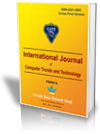A Dual Objective Scheduling Scheme for Computational Grids

V.Daya Sagar Ketaraju,Dr.M.V.L.N.Raja Rao, Dr. G.V.S.N.R.V.Prasad "A Dual Objective Scheduling Scheme for Computational Grids"International Journal of Computer Trends and Technology (IJCTT),V4(4):744-750 April Issue 2013 .ISSN 2231-2803.www.ijcttjournal.org. Published by Seventh Sense Research Group.
Abstract: -A computational grid has two characteristics: it must allow resource providers and resource consumers to make autonomous scheduling decisions. In this paper, we formulate this intuition of optimizing incentives for both parties as a dual-objective scheduling problem. The two objectives identified are to maximize the success rate of job execution and to minimize fairness deviation among resources. The challenge is to develop a grid scheduling scheme that enables individual participants to make autonomous decisions while producing a desirable emergent property in the grid system; that is, the two system wide objectives are achieved simultaneously. We present a dual object scheduling scheme, which utilizes a P2P decentralized scheduling framework, a set of Griddy local heuristic algorithms, and three market constraints of job announcement, price, and competition degree. The performance of this scheme is evaluated via extensive simulation using Grid simulator. The results show that our approach outperforms other scheduling schemes in optimizing incentives for both consumers and providers, leading to highly successful job execution and fair profit allocation.
References-
[1] Lijuan Xiao, Yanmin Zhu, Member, IEEE, Lionel M.Ni, Fellow, IEE, and ZhiweiXu, Senior Member, IEE “Incentive Based Scheduling for Market Like Computational Grids”IEE tractions on Parallel and distributed systems, vol no.7 July 2008.
[2] R. Buyya, D. Abramson, and S. Venugopal, “The Grid Economy,” Proc.IEEE, vol. 93, no. 3, pp. 698-714, 2005.
[3] R. Buyya, D. Abramson, and J. Giddy, “Nimrod/G: An Architecture of a Resource Management and Scheduling System in a Global Computational Grid,” Proc. Fourth Int’l Conf. High-Performance Computing in the Asia-Pacific Region (HPC Asia), 2000.
[4] O. Regev and N. Nisan, “The POPCORN Market: An Online Market for Computational Resources,” Proc. First Int’l Conf. Information and Computation Economies (ICE ’98), pp. 148-157, 1998
[5] R. Wolski, J.S. Plank, T. Bryan, and J. Brevik, “G-Commerce: Market Formulations Controlling Resource Allocation on the Computational Grid,” Proc. 15th Int’l Parallel and Distributed Processing Symp. (IPDPS ’01), p. 8, 2001.
[6] K. Lai, L. Rasmusson, E. Adar, L. Zhang, and B.A. Huberman, “Tycoon: An Implementation of a Distributed, Market-Based Resource Allocation System,” Multiagent and Grid Systems, vol. 1, no. 3, pp. 169-182, 2005
[7] L. Xiao, Y. Zhu, L.M. Ni, and Z. Xu, “Grid IS: An Incentive-Based Grid Scheduling,” Proc. 19th IEEE Parallel and Distributed Processing Symp. (IPDPS ’05), p. 65, 2005.
[8] Computational Grids, Ian Foster Mathematics and Computer Science Division Argonne National Laboratory Argonne, IL 60439 Carl Kesselman Information Sciences Institute University of Southern California Marina Del Rey, CA 90292.
Keywords — Computational grid, scheduling, incentive, peer to peer, Grid Simulator.


